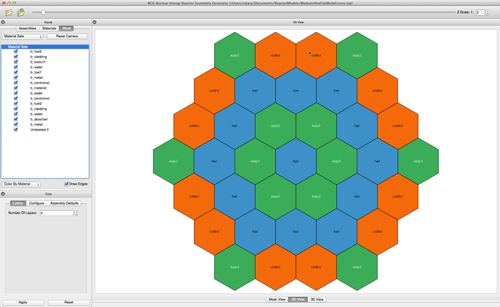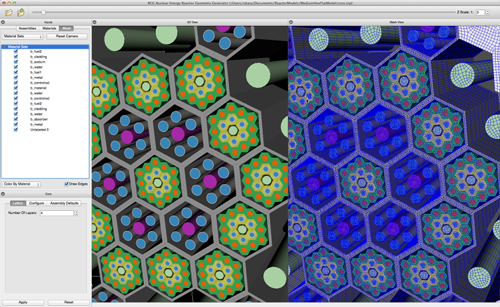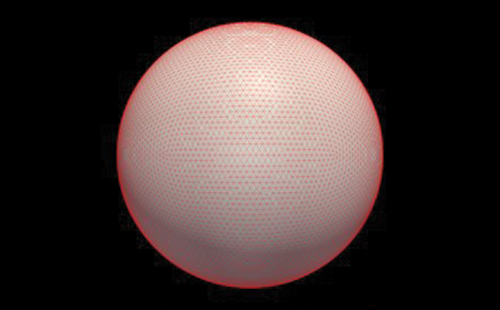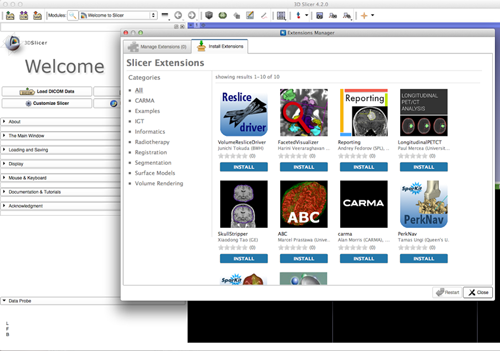Recent Releases

RGG 1.1 Released
Kitware is pleased to announce the release of Reactor Geometry Generator (RGG) 1.1. RGG allows engineers to design advanced nuclear reactor core models and to create proper analysis meshes based on the models.
Version 1.1 utilizes next-generation rendering improvements made to VTK, allowing the designer to model and interact with nuclear cores consisting of up to 100,000 pins and rods, while the improved GUI provides separate schematic, 3D, and mesh views. In terms of model and mesh generation improvements, MeshKit’s AssyGen and CoreGen tools are now bundled with the application, eliminating the need for users to build them separately. In addition, version 1.1 of RGG supports running AssyGen and CUBIT in parallel, which reduces model and mesh construction time. Another improvement is that non-RGG created meshes in Exodus format can now be displayed in RGG. Finally, users can export subsets of their meshes based on material.
To learn more and to download RGG 1.1, please visit http://www.computationalmodelbuilder.org/rgg/.
ITK 4.7.0 Released
ITK 4.7.0 was released in December. Congratulations and thank you to everyone who contributed to this release.
Documentation improvements for the release include updated Software Guide registration examples to the ITKv4 framework and a clean Software Guide dashboard build. ImageIO improvements include PNG sCAL unit support, enhanced support for system GDCM, and updates to MetalO. In addition, several infrastructure and filtering improvements were made. For example, there is a new method to erase a MetaDataDictionary entry, a new global method to set physical space tolerance, and new experimental thread pool support.
The release also features important bug fixes, wrapping improvements, performance improvements, registration improvements, and new remote modules.
To try the new software, please visit ITK’s download page.
Triangle Mesh Subdivision image created using code from the release. Image courtesy of Zhu W., School of Psychiatry, University Of New South Wales. http://hdl.handle.net/10380/3307
CMake 3.1.0 Released
Kitware is pleased to announce the release of CMake 3.1.0. In this release, support for Windows Phone and Windows Store was added to Visual Studio 11 (2012) and above Generators. In addition, NVIDIA Nsight Tegra support was added to Visual Studio 10 (2010) and above Generators.
Also new in CMake 3.1.0: The “if” command no longer automatically dereferences variables named in quoted or bracket arguments; the target property “SOURCES” supports “Generator Expressions”; and the syntax for Variable References and Escape Sequences was simplified to allow for faster parsing.
Furthermore, a new “target_compile_features” command allows for populating target-based compile features; ctest now supports Intel coverage files with the “codecov” tool; and CPack supports lzma compressed archives.
The source and binaries for CMake 3.1.0 are available on the CMake download page, and documentation can be found on http://www.cmake.org/documentation/.
Slicer 4.4 Released
The Slicer community recently announced the release of Slicer 4.4. Developed in collaboration with the National Association for Medical Image Computing (NA-MIC) and the broader Slicer community, Slicer 4.4 is a free, open-source (BSD-style license) software platform for the segmentation, registration, visualization, and analysis of medical images for preclinical and clinical research involving disease detection, diagnosis, treatment planning, response monitoring, population analysis, and image-guided therapy. Available for Linux, MacOSX, and Windows systems, Slicer is extensible, with powerful plug-in capabilities for adding algorithms and creating custom applications.
Features of Slicer include support for multi-modality imaging such as MRI, CT, ultrasound, nuclear medicine, and microscopy; a bidirectional interface for devices; and multi-organ support from head to toe. Spearheaded at Kitware by Jean-Christophe Fillion-Robin, Slicer 4.4 introduces an improved App Store, known as the Extensions Manager, for adding plug-ins to Slicer. Currently, over 50 extensions are available.
Other major Slicer 4.4 features include an improved Transforms module with support for non-linear transforms and visualization of transforms in 2D and 3D, a new Subject hierarchy module to efficiently organize and manipulate data loaded in Slicer, and a new Landmark registration module for interactive registration. In addition, Compare Volumes was added to allow for the creation of an overview of one or more volumes, and the user interface was improved for Colors, Markups, DICOM, and Interactive Editor.
In total, Slicer 4.4 includes close to 400 feature improvements and bug fixes for enhanced performance, utility, and stability. For a complete list of highlights, please see Slicer’s Wiki page, and to download version 4.4 of Slicer, please visit http://download.slicer.org.
Slicer consists of over 370,000 lines of code, most of which are written in C++. Slicer.org is the portal to the application, training materials, and developer community.



